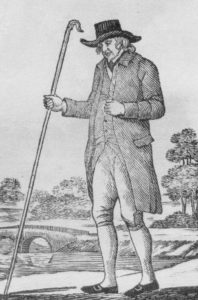
an act authorizing new toll funded
roads in the Knaresborough area.
Metcalf won a contract to build
a three-mile section on a new
road from Harrogate to Boroughbridge.
He surveyed the countryside alone
and worked out the most practical route.
Metcalf built roads in Lancashire,
Derbyshire, Cheshire and Yorkshire
The rolling English drunkard made the rolling English road.
Before the advent of motorways in the UK (first section of the first – the M1 opened in 1959) it was true that almost any straight road you found in England was built by the Romans.
The burst of road building during the industrial revolution meant generations of British schoolchildren introduced to the marvel of Blind Jack of Knaresborough – John Metcalf – who tap-tapped his way across northern England surveying the land for roadbuilding in spite of losing his sight at age six.
The agricultural and industrial revolutions demanded better transportation. Many roads were built on the beds of lanes, pathways, and tracks made by the feet that trod them as people, their animals and goods moved from farm and cottage to village and town. Roads were the connective tissue tracking the lives of the people who came with news and goods and services to sell and left to find their fortunes. Off to market, off to war, off to school, off to the pub, off to church and going courting. Ancient trails like the Ridgeway were the exception – connecting the ancient hill forts in a direct conduit.
Road and roads – the metaphors for life and life’s choices, the way to the longed for, dreaded destination. Traveling in hope, anticipation, expectation. The road brings the stranger to town and leads the wanderer away from home. The path for the perilous journey toward the holy grail of discovery and arrival, somewhere, anywhere. Traveller, there is no road.
Not surprising then that “road” features in so many expressions, idioms, and in the titles of books, films and songs.
Sylvia Plath’s Esther is bored and depressed by the road ahead:
I saw the years of my life spaced along a road in the form of telephone poles threaded together by wires. I counted one, two, three… nineteen telephone poles, and then the wires dangled into space, and try as I would, I couldn’t see a single pole beyond the nineteenth. ― Sylvia Plath, The Bell Jar
For Wendell Berry in Rememberings the road is a brutal intrusion on the landscape, a wound like a sewer pipe on the land, a gouge blind to history and nature
The eight lanes of the interstate become six and then four. The traffic thins. … the road is the city’s hardened effluent, passing through its long gouge without respect for what was there before or for what is alongside it now. The road reminds him, as it always has before, of the power of words far removed from what they mean. The road is a word, conceived elsewhere and laid across the country in the wound prepared for it: a word made concrete and thrust among us.
For Edward Thomas – responding to Robert Frost’s poem – “All roads lead to France”. He enlisted and was killed at the Battle of Arras in 1917. “The Road Less Travelled” is America’s favorite poem.
The Road Race Ahead
The road ahead is
The silk road to ruin.
Long and winding, yellow-brick
Paved with good intentions.
The straight and narrow Abbey Road to nowhere.
The royal road to the unconscious king
Of the road to riches who hits the road and kicks the can
Down where the rubber meets the middle of Damascus.
The road bends and twists and turns and
When you come to a fork
Take it.
Paved, unpaved,
Well-trod or less travelled,
It’s a one-way slippery slope
Uphill to the two-lane highway.
One more for the dead end road to victory.
Follow the rules of the road
Or fall for the speed bump roadside attraction.
The road show signs
Where the one for the roadkill chicken crossed
The open road to your heart.
Off the road safety.
On The (high) Road trip is
The low road to the primrose path.
Travel the Rocky Revolutionary Ghost Road to Coorain
Or a Thunder Road to Oxiana.
Why don’t we do it in the 84 Charing Cross?
Two for the Road to Singapore, Hong Kong, El Dorado Zanzibar and Rio.
The road to Toad Hall. Poop! Poop!
All aboard
The underground railroad
Through the woods is closed to freedom.
Tobacco Road Back to
Wigan Pier and Glory.
Cross road rage to road rash
Dirt road hog to road crash
Back on the lonesome road again
Can’t cry on the road to recovery shoulder
Road gang
Road movie
Road map
Road kill
Roadworthy
Roadrunner
Trunk road block
Inroad
Escape road works
Take me home country roadhouse
At the end of this road, so time to get the show on ….
This is Dorothea Lange’s Highway to the West from 1938.
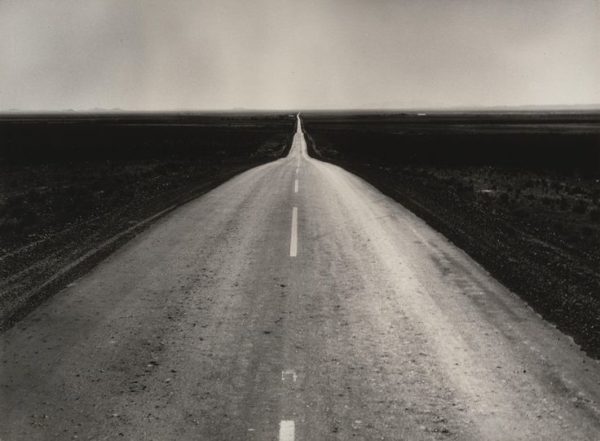
John Steinbeck described such a road:
Highway 66 is the main migrant road. 66–the long concrete path across the country, waving gently, up and down on the map, from the Mississippi to Bakersfield–over the red lands and the gray lands, twisting up into the mountains, crossing the Divide and down into the bright and terrible desert, and across the desert to the mountains again, and into the rich California valleys.
66 is the path of a people in flight, refugees from dust and shrinking land, from the thunder of tractors and shrinking ownership, from the desert’s slow northward invasion, from the twisting winds that howl up out of Texas, from floods that bring no richness to the land and steal what little richness is there. From all of these the people are in flight, and they come into 66 from the tributary side roads, from the wagon tracks and the rutted country roads. 66 is the mother road, the road of flight. – The Grapes of Wrath Chapter 12
As in the Blues and the Dust Bowl ballads – the road is the way out to hope and salvation, the exodus. Bill Bill Broonzy had the Key to the Highway and Robert Johnson was at the Crossroads
… the rain quit and the wind got high
Black old dust storm filled the sky
I traded my farm for a Ford machine,
Poured it full of this gasoline
And started . . . rockin’ and a rollin’
Out to the old California . . . fruit bowl– Woody Guthrie “Talkin’ Dust Bowl”.
In this painting from 1919, Nevinson shows the road south from Arras to Baupaume in France. This was a major supply route for the Allies and Nevinson depicts a never-ending road leading up and down and up again through a bleak, flat and featureless landscape of tree stumps and army encampments into a pale distance.
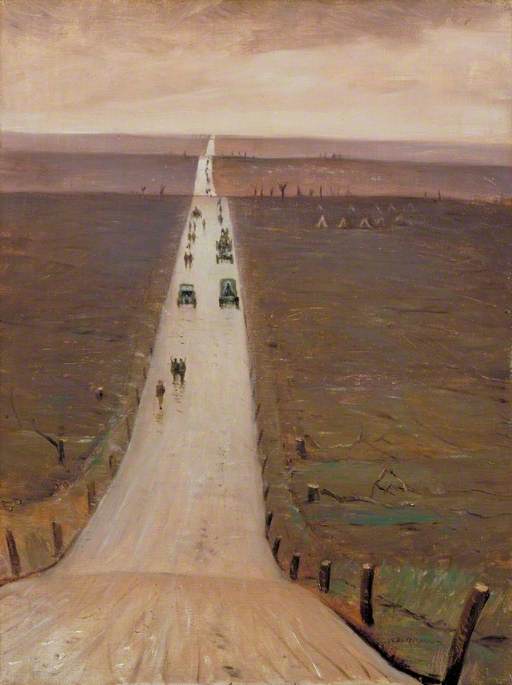
Here’s another ominous road on the Western Front:
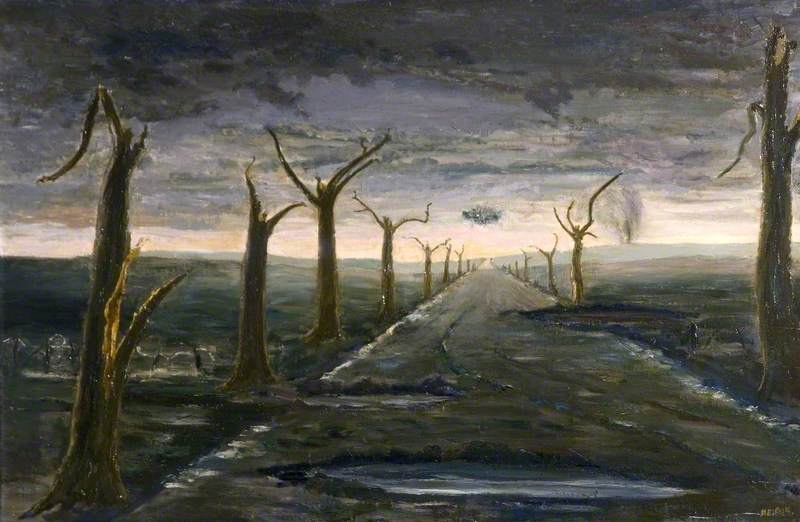
And another:
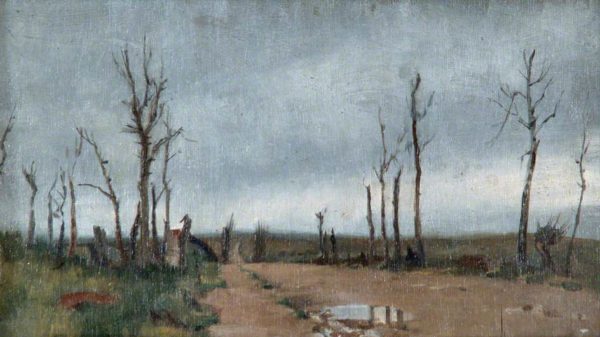
And of course, Paul Nash. (Traveller, there is no road. Literally.)
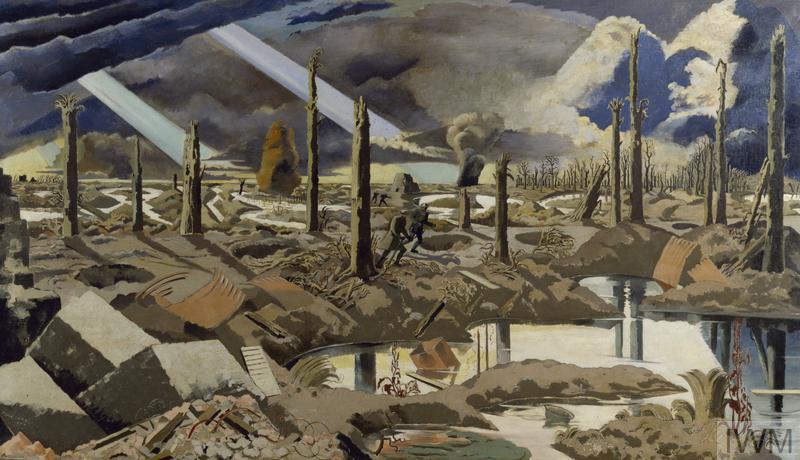
Mary Riter Hamilton had roads too and here they are again:
And before the war The Road to the Somme had quite a different meaning. And look.
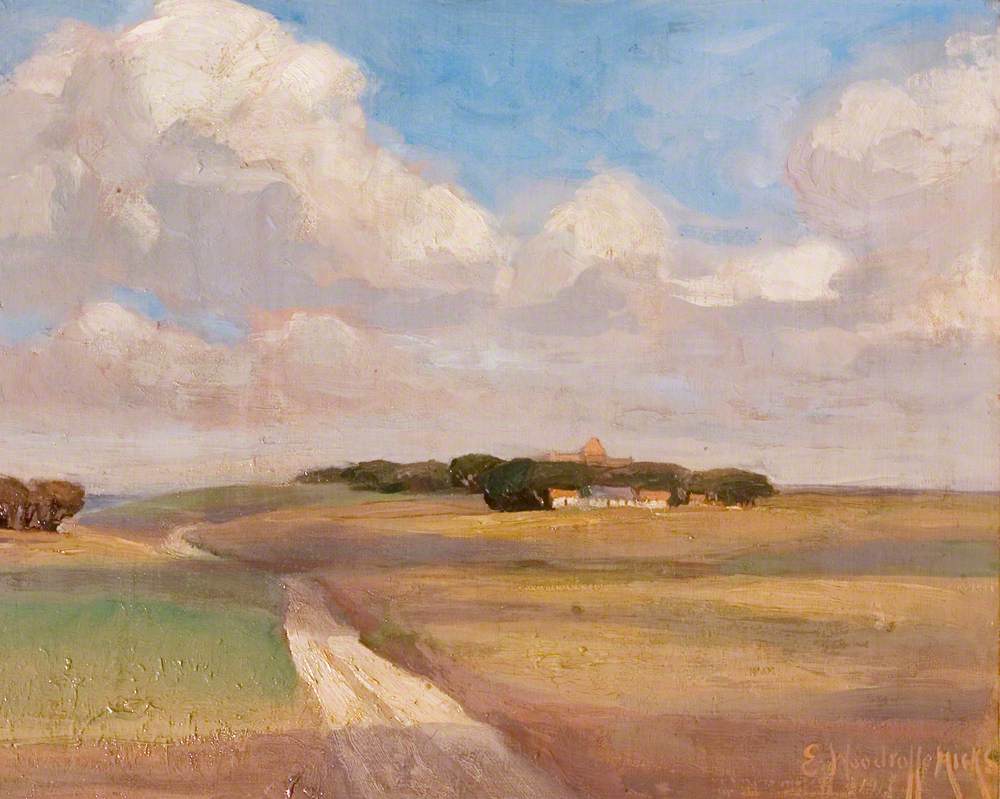
So in keeping with that more cheerful note here is verse from G.K. Chesterton:

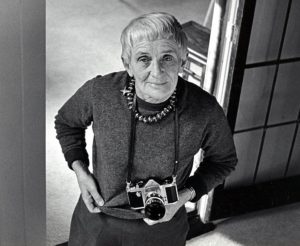
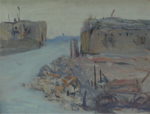
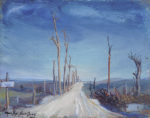
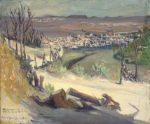
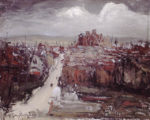
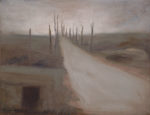



How peaceful and nurturing was the road to the Somme until men on each side, though fear, threw bombs at each other and turned it into a desolate and destroyed place nurturing no one. So may these pictures remind us to try always not to throwing bombs.
Rambling Jackie of Beachy Head by way of Birmingham go for it!
I have read the beginning and the end and looked at the pics. I shall read it all when awake. I love the idea of going to Beachy Head by way of Birmingham except Birmingham isn’t supposed to be worth a visit. But I would never do it as have to plan journeys on maps before I venture anywhere..preferably an O.S. I also like rambling Sid Metcalf. The combination may account for some of the winding roads and strange posted distances to in Norfolk.I love these posts!